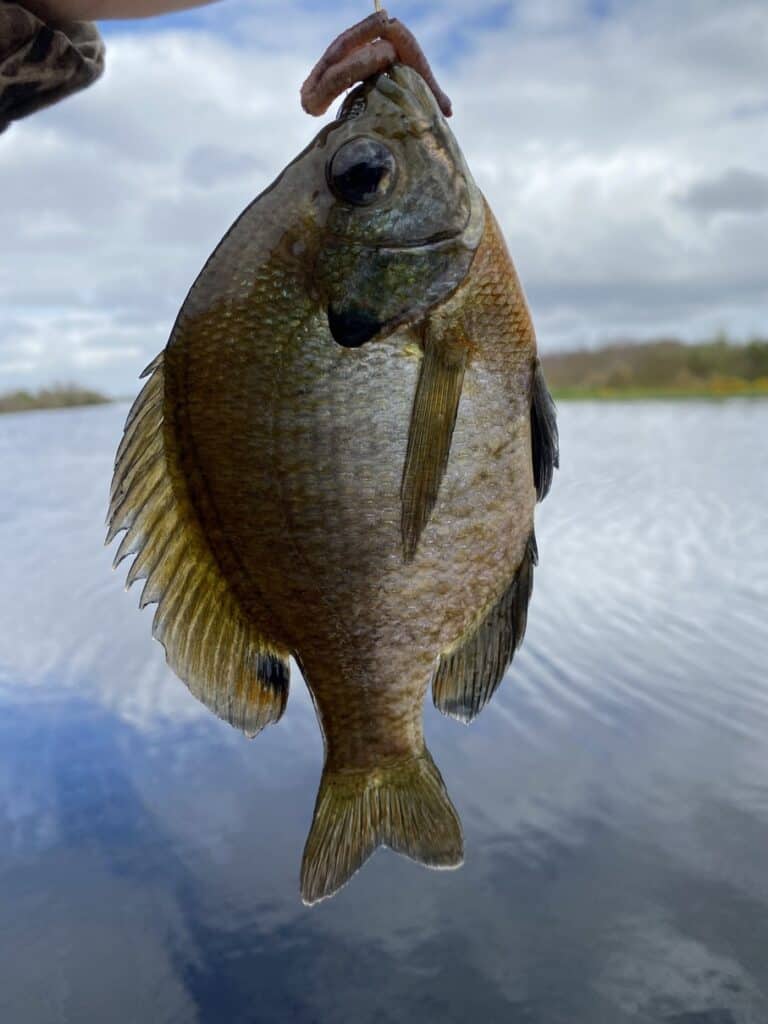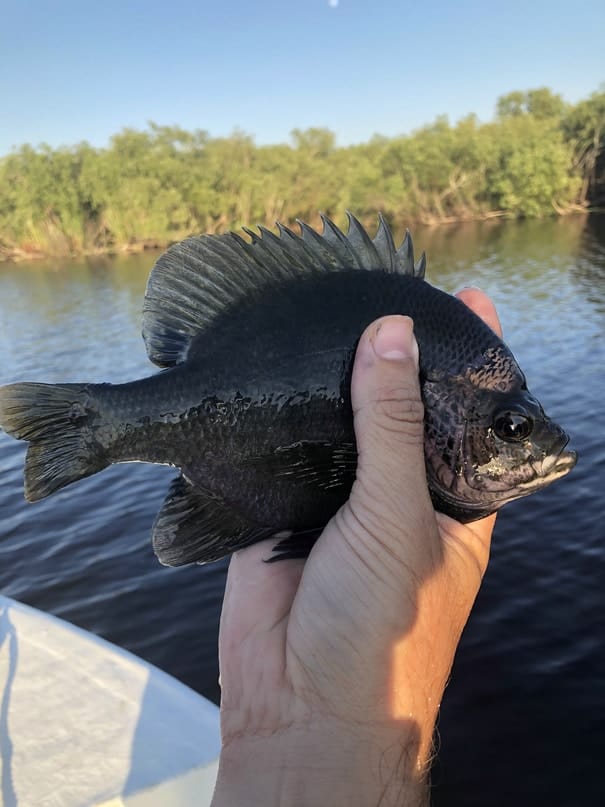Bluegill vs Sunfish: Are they the same?
Sunfish are a family of freshwater fish (Centrarchidae) native to North America. This family of fish is comprised of 34 different species living today. One of the most widespread and common species is the Bluegill. Therefore a Bluegill is a member of the sunfish family, but a sunfish is not specifically a bluegill. These fishing terms are often interchanged by anglers but they are distinctly different.
To put it simply: A bluegill is a type of sunfish…but not all sunfish are bluegill.
As an example, Let’s look at the dog family group of Terriers. This family of dog breeds is comprised of 33 different species, such as the Yorkshire Terrier, Bull Terrier or Jack Russell Terrier.
ALL of these dogs are terriers, but each has a distinct size, color, and disposition. A Bull Terrier is not the same as a Jack Russel Terrier.
The same goes for Sunfish and Bluegill. The Bluegill is a specific type of Sunfish just the same as a Yorkshire is a specific type of Terrier. But not all Terriers are Yorkshire, just like not all Sunfish are Bluegill. Make sense?
So what is a Sunfish?
The term ‘sunfish’ does not scientifically refer to a specific fish species. Sunfish are a family of freshwater fish (Centrarchidae) native to North America. This family of fish is comprised of 34 different species that exist today. Some of them may surprise you!
Did you know that Largemouth Bass, Smallmouth Bass and Black Crappie are all members of the sunfish family?
Many of these species share similar characteristics, size, colors and habitats which can lead to confusion when trying to identify them. Here is a full list of all the fish species in the ‘sunfish’ family:
What is a Bluegill?
Bluegill (Lepomis macrochirus) is a freshwater fish species that is a member of the sunfish family. They are the most common and widely distributed of all the sunfish species. Bluegill are often referred to as ‘sunfish’ by anglers. Other nicknames include ‘bream’, ‘coppernose‘ or ‘sunny’s’.



Appearance– Bluegill have the deep-bodied look of panfish, a small mouth, long dorsal fin, and a slightly forked tail. Their distinct feature is a dark ear covering and a blotch at the dorsal fin’s back bottom edge.
They are found throughout North America from Mexico to Canada and have even been introduced into other parts of the world.
Habitat– Bluegill can be found in a wide variety of habitats, ranging from roadside ditches to deep natural lakes. They prefer the still waters of freshwater lakes, ponds, lagoons and quiet creeks but can also be found in canals, reservoirs and rivers.
They seek out cover in aquatic vegetation such as hydrilla, lilypads and cat-tails or find refuge in structure such as dock pilings, brush piles, and submerged logs.
Behavior– Bluegill feed primarily on insects and their larvae, but they will readily take worms, small minnows and freshwater crustaceans.
Throughout early spring and summer, Bluegill spawn and create “beds” in shallow sandy areas where males defend the nest from predators. They are prolific breeders and it is not uncommon for anglers to catch 50-100 fish per day.
Fishing Tips- Grass shrimp, live worms and crickets are the best live baits to use when targeting bluegill. For artificial, the best lures for Bluegill are a beetlespins, surface poppers or ultra-light crankbaits.
Bluegill bite best during early morning and late afternoons but can be caught all day long in the warmer months of spring and summer. Focus on vegetated areas, usually in 8 feet of water or less. Where there is one bluegill, there is usually more!
How do you identify a bluegill?
The easiest way to identify a bluegill is to look for 3 main features:
- Long dorsal fin
- Dark Opercular flap (ear covering)
- Dark spot or blotch at end of dorsal fin
The appearance of bluegill can vary quite a bit. Some individuals may have dark shades of purple and brown, and others may be light green or copper-colored with visible bands. This variability is due to size, regional location, diet, sex, and even water quality.
So what is a Bream/Brim?
Bream is another term often used to describe small freshwater ‘sunfish’ or ‘panfish’. It is interchangeably used by anglers when referring to small bluegill and other sunfish… especially those caught in ponds, creeks or small waterways. Its just a generic term!
“Let’s take the kids down to the pond to catch some bream” or “All we caught were a few small bream and a catfish”.
The truth is, ‘Bream’ is actually a scientific term for a family of fish native to Europe in the genus Abramis. In other words, bream is not a specific species in North America; it’s a term that is colloquially used to describe a small freshwater fish with a deep body and short size (like a bluegill).
But in Europe, Bream can refer to a variety of freshwater fish with deep narrow bodies. small scales and shiny appearance. These bream are often pursued by anglers and much different than the North American term for “bream”.
Why the confusion?
Well, the beauty of fishing is that it does not follow a specific rule book. There are no Standard Operating Procedures for fisherman, and many of the terms are regionally developed over generations.
These terms and trends vary depending on who you talk to, and how they were taught to fish.
Fishermen are notorious for telling tall tales, bending the truth, and coming up with slang terms for fish. It’s part of the fun!
How do you identify the other freshwater Sunfish species?
Many of the sunfish species do look similar, especially those in the genus Lepomis. There are many resources online to identify freshwater fish, so here are a few tips:
- Document your catch. Where was it caught? What did you catch it on?
- Measure your catch. How long was the fish from the mouth to tail? Get a weight if possible.
- Take good photos of your fish! Try to take a photo from both sides, with a bump board or ruler as reference.
Next, contact your state fish and wildlife agency. All 50 states have a department of natural fisheries staffed with biologists who can answer your question and positively identify your catch.
To find a list of where to get started find your state by clicking here: https://www.fishwildlife.org/landing/membership/member-list
Get in touch with the Freshwater Fisheries department. They would love to hear about your catch, and can positively ID it for you. They may even give you some fishing tips on opportunities in your area!
See Also: What Are Panfish & Where Did The Name Originate?
Additional Reading
- Crazy Facts About the World Record Crappie
- What Size Hooks for Smallmouth Bass? Quick Guide
- Large and in Charge-Mouth: 10 of the Best Bass Lures of All Time (And Where to Buy Them)
- Emperor of the Sun(fish): What You Need to Know About the World Record Bluegill
- Coppernose Bluegills: How They’re Different from Common Bluegill
- Bluegill vs Brim: Differences & Terminology, Explained!











































